Text
Critical Reflection
In my current studio 2 project in the MoP program, I use photography to explore themes of partition, diaspora and inter-generational trauma using memory. When I began my research any archival photographs that belong to the partition of the Indian Subcontinent have mostly been photographed from a colonial gaze – displacement, chaos and violence. While these images evidently tell a broader situation happening in India at that time, what went missing were the personal narratives of millions of people that were displaced. I intend to collect and resurrect the lost narratives of the displacement and trauma of Punjabi refugees of 1947. It is an attempt to understand my own cultural identity by preserving intergenerational traditions, anecdotes and belongings passed on as a token of remembrance.
I have always found difficulty in situating my work within any particular methodological framework because I’ve always made work revolving around psychoanalysis of my own childhood trauma which was mostly a result of growing up in a dysfunctional refugee family. Hence, the critical frameworks I’m researching mostly revolve around auto-ethnography and decolonisation of photography.
In my dossier, most of the research references I have are non-western photographers and artists who are using traditional studio practices (majorly India) and photographs to build diasporic narratives work towards decolonising the photographic image. However I also draw inspiration from photographers like Jeff Wall and Max Pinckers whose practice blur the line between reality and speculation. The landscapes and the narratives in my photographs are mostly created from family memory, this project situates itself in the expanded documentary genre.
For this project I draw inspiration from Geoffrey Batchen's 'Forget me Not' and Susan Sontag 'On photography'. Sontag positions photography as an evidence taking tool and describes the dual nature of photographs as a pseudo presence and also a reminder of absence. (Sontag, 1977)
My current ongoing series is a non-linear narrative that contains portraiture and still-life photography. I photograph people who have experienced partition directly or indirectly through stories from their parents or grandparents. I have recreated a traditional Indian studio from my memory which uses a hand painted scenic backdrop very similar to the landscapes my grandparents crossed when they migrated. The metallic pot vessels I stage and photograph as a still life series contains fragments of my memory of my grandparents. It is an everyday vessel used to store liquids in an Indian household and is also used to carry the ashes of a person after they pass. What's fascinating about this vessel is how the meaning of the same object changes. With these images I want to shine light on the narratives of Paritition that are forgotten.
0 notes
Text
Can one listen to Images?
I came across this beautiful series while reading 'Listening to the Images' by Tina Campt. The exhibition named 'Gulu Real Art Studio' contains hundreds of faceless photographs originally taken by Obal Denis and collected by Italian photojournalist Martina Bacigalupo.
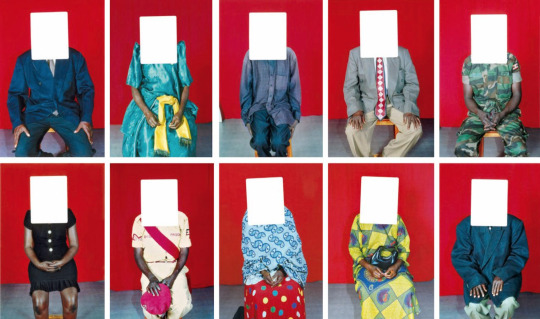
I had a very strong emotional reaction the first time I saw these images. As soon as your eye moves from the background to the subject, the studium changes to the punctum as you notice the absence of the faces. These images taken by the Gulu Real Art studio in Uganda create a very fascinating vernacular portraiture. The fact that are discarded cutouts from the African identity photos reinstates the fact that like everywhere else a photograph still remains a privileged medium of authentication.
In my series, I have a few headless photographs of the subjects kept alongside passport sized images of them. I constantly think about how those will be read among a wider audience. Will it be disrespectful to the subject? While my initial intention was to focus on the attire, backdrop and carpet instead of the face as a reminder of the lost time, I could feel the punctuation it causes when kept next to the portraits.
Campt, Tina M. Listening to images. Duke University Press, 2017.
0 notes
Text
Brown History Podcast by Ahsun Zafar
I've been listening to this podcast since the start of this semester. This particular episode revolves around the area of my research. In this episode the podcaster Ahsun Zafar discusses with oral historian Anchal Malhotra about how memory of partition is passed from one generation to another. What are the factors under which the first generation decides not to discuss a particular event?
This podcast shared some valuable points on how to navigate a conversation to the survivors of such an event while I'm interviewing and photographing people who belong to such a diaspora.
Zafar, Ahsun. “EP 43: Descendants of Partition.” BROWN HISTORY PODCAST. BROWN HISTORY PODCAST, September 1, 2022. https://www.brownhistorypodcast.com/episodes/ep-43-descendants-of-partition. Accessed on October 08, 2022.
0 notes
Text
Grace Lau

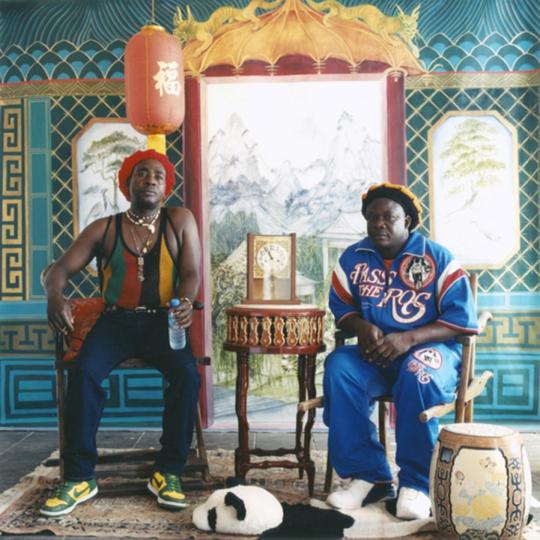
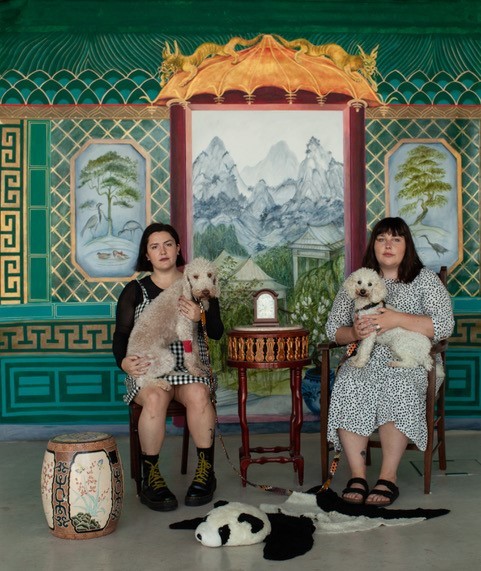

In a search for Indian vernacular photography, I came across Grace Lau's project "Portraits in a Chinese Studio." Even though the project has no link to India or photography in India, there is a resemblance in aesthetics especially the hand painted backdrop. These were very common in Portrait photography from 1860s until the 1920s. This project inspired me to dive deeper into the vernacular imagery from India.


Grace mentions that by reversing roles she has become the Imperialist photographer who is capturing her exotic subjects at the "Port" of Hastings. In her photographic study "21st Century Types" (later retitled "Portraits In a Chinese Studio"), Lau has reversed the roles, positioning herself as the Imperialist photographer, documenting her exotic subjects in the Port of Hastings, South East England, in response to the Imperialist visions of the exotic Chinese made by Westerners during the turbulent years in China between the Opium Wars and the Boxer Rebellion. Through this project, she is subtly criticising the Imperialist perceptions of the "exotic" Chinese. Through the creation of my manufactured tableaux and the conflating of history, the issue of cultural representations in the archive is brought to light. In a British seaside resort in the summer of 2005, she has developed a special archive of 400 subjects.
Due to colonial influence on India, the traditional portraits in India also used the hand painted backdrop. For my studio practice, the people I'm photographing sit in a very similar tableau manner, in front a hand-painted backdrop from India, with objects that remind them of their past. The idea is to create a Mise-en-scène of an Indian photo studio from my memory. The subjects unlike Grace's studio are not exotic to me, they belong to the same diaspora as mine and to them I'm just like their local photographer.
Lau, Grace. “Portraits in a Chinese Studio.” Grace Lau, August 1, 2022. https://gracelau.co.uk/project/portraits-in-a-chinese-studio/.
0 notes
Text
Indianisms by Pranshant Panjiar

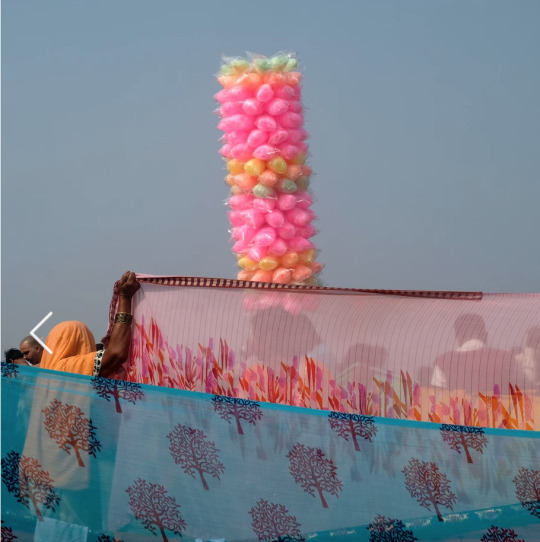

India has been vastly explored by western and Indian photographers alike and Prashant Panjiar's documentary work capturing the social and political issues in India since 1980s cannot go unnoticed. I have been following Prashant's documentary work since I was a teenager but this particular ongoing project named 'Indianisms' is different from Panjiar's other work. In this project, Panjiar has used documentary photography to explore and celebrate the vernacular imagery extremely symbolic to India.
Panjiar states that the irony, eccentricities, incongruity, and inventiveness of Indian vernacular iconography have long piqued his curiosity. Around 2010, he went back through his archive to discover a new approach for his photography, he discovered a large number of his photographs that appreciated this local imagery. (Panjiar, 2010).
The images in this series have cultural nuances like the hand painted ticket box, a local theatre artist preforming and colourful fabrics with candy floss transport you to a simpler time. I think a lot about the meaning of these indexical signs in Panjiar's observational work. In my practice observation plays a big role. As my project involves a lot of ‘memory work’, this project inspired me to look back at the cultural iconography that belonged in the domestic household I grew up in. I have also started collecting photographs and undeveloped negatives that belong to the elder generations to look for visual cues that might help me stage my photographs.
Panjiar, Prashant. n.d. “INDIANISMS | Prashantpanjiar.” Prashantpanjiar. www.prashantpanjiar.com. Accessed August 26, 2022. https://www.prashantpanjiar.com/indianisms.
0 notes
Text
Atong Atem
Atong Atem is a south sudanese artist based in Melbourne currently. She uses photography and video to explore migrant stories and post colonial practices in the African diaspora.
Atong Atem is one of my favourite contemporary photographic artist. Her work challenges the colonial gaze. For my studio 2 project, Atem's film work Banksia inspired me a lot. In Banksia, Atong Atem delves into the lesser-known history of this nation's first African immigrants, a history that predates the arrival of Atem's own family from South Sudan in 1997. However, she feels that colonial history is frequently told from a European viewpoint.


What drew my interest in this project that it takes a non-colonial approach to migrant stories which is very similar to what I'm trying to achieve. Atem mentions, recalling colonial books and records she has read about the Dinka people's history and customs and claims that none of that is true, yet when people search for truthful research or reporting about her community—been that's what's legitimised.
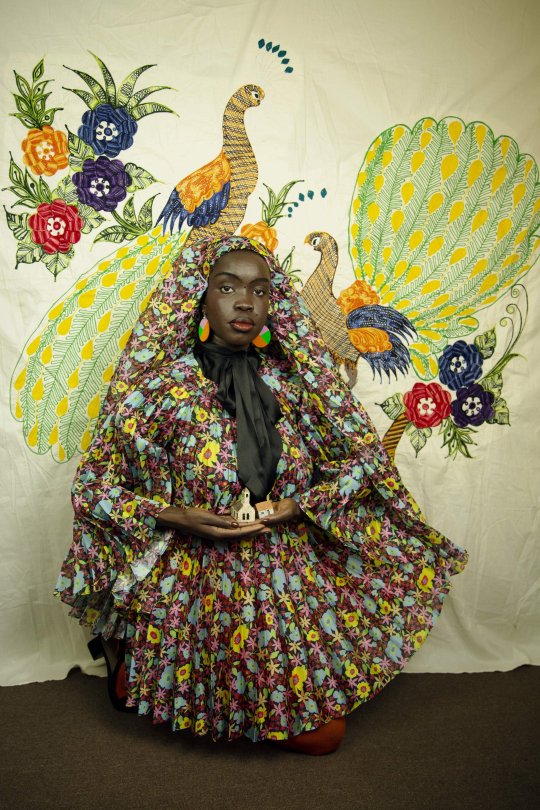

The constant use of the idea of retrofuturism in Atem's work is what interests me the most. It feels like acknowledging, appreciating, and taking part in the past—however tangled and painful—in a generous and unapologetically expansive way that leaves place for joy and lightheartedness next to sorrow and truth. I feel empowered looking at Atem's work while I'm photographing people from my own community.
West, Phoebe. “Atong Atem's Film Spotlights African Migrants in Australia.” WePresent, August 11, 2022. https://wepresent.wetransfer.com/stories/atong-atem-banksia.
0 notes
Text
The Fourth Wall by Max Pinckers
Max Pinckers and his idea of speculative documentary photography has always fascinated me. The Fourth Wall makes an effort to demonstrate how fiction shapes reality via the love of Indian cinema. Passersby on Mumbai's streets spontaneously choose their own roles to act out for the camera, turning them into performers. They give it their all, reflecting on their silver screen fantasies by embracing our shared visual universe and constructing their own individual fleeting suspensions of disbelief. They are aware of the power of images.
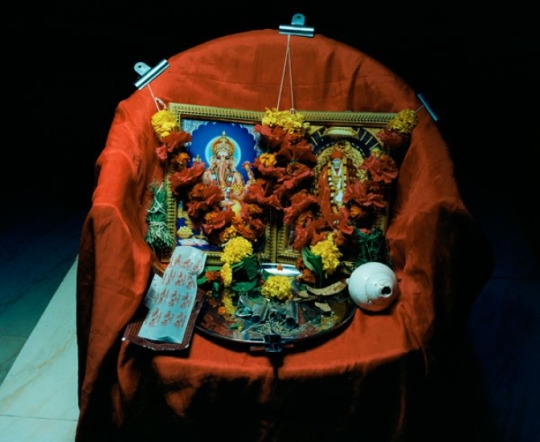
Looking at this work, the line between fiction and fact becomes muddled and meaningless by fusing these performative photos with still lives created on genuine movie sets and newspaper stories that deal with some type of transgression between imagination and reality.


The narratives I'm recreating in my studio in Melbourne are from the people I'm photographing and my childhood memory of growing up in India. Now since I can't go and photograph my subjects in the landscapes that experienced Partition, I've built a set which my subjects sit in front of. The use of already built movie studios in Pinckers' work gives me insights on how to use performance in my photographs.
Pinckers, Max. The fourth wall : Max Pinckers, 2012. https://www.maxpinckers.be/projects/the-fourth-wall/.
0 notes
Text
Indian Photo Studio
Ketaki Sheth visited around 65 photo studios while travelling throughout India between 2015 and 2018, the many of which were in a dismal state of collapse. Numerous photographers have travelled to and written in-depth articles about photo studios in India.
Sheth's method of working at the picture studios is anything from conventional because she frequently flouted the rigid rules of taking stiff, mannered images of people with enigmatic looks. Instead, she exhumed legends of former glory and focused viewers' attention on objects and a cast of characters who gracefully submitted to her gaze while using one handheld camera and lens and outdated studio lights when available.
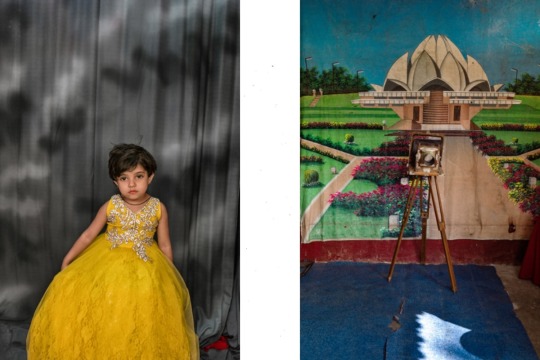
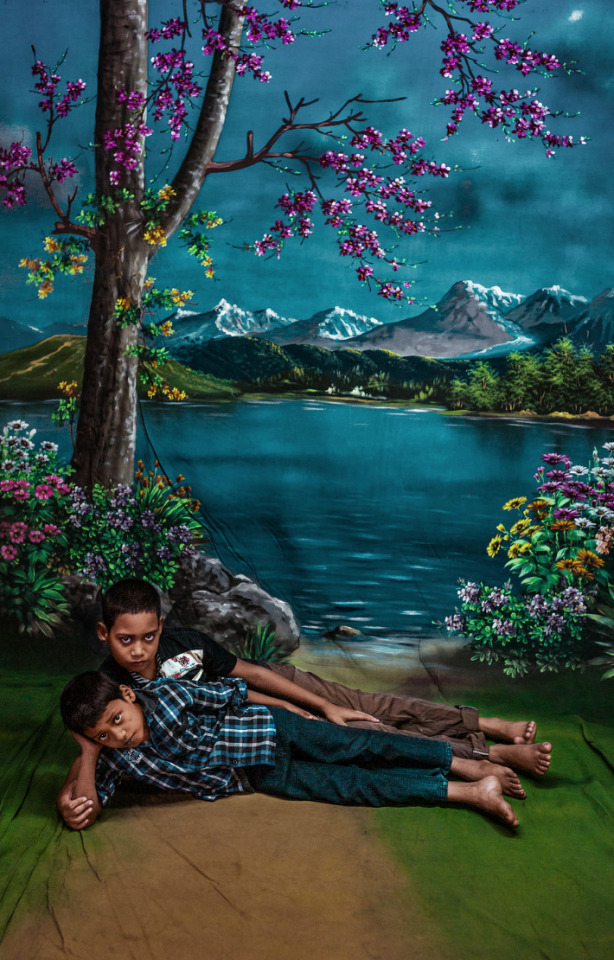

In my current studio praxis, I'm using the exact same methodology that is used in a traditional Indian photo studio. Sheth's photo studio helped me study the lighting styles and also led me to actually find a backdrop maker in Delhi who made a backdrop for me. Christopher Pinney states that these studio backdrops have long been used as imaginative settings for fantasies, goals, and longings throughout their comparatively brief cultural history. It has both established and upheld graphical conventions while also defying them.
In my understanding the backdrop is first and foremost a location for the exchange of technical expertise, desires and social customs. Whether it takes the form of a fancy 19th-century attic studio, a characterless shopping mall cubicle, a temporary setup in a student admission office, or the portable backdrop of a street peddler portraitist much like Henri Cartier-Bresson's image 'Street Photographer', it is either a replica of current societal norms and traditions or a short-term haven from them, depending on the wish. Even though it is a rapidly declining practice, the sociability and ceremonial character of vintage photographer's studio background traditions seem to have a certain allure even today.
Photoink. “Exhibitions: Photo Studio.” PHOTOINK, October 13, 2018. https://www.photoink.net/exhibitions/photostudio.
0 notes
Text
Ghar by Anu Kumar
Anu Kumar is a Melbourne based photographic artist who predominantly uses medium format photography to explores issues of displacement and the diaspora. She utilises her work as a window into her identity as an Indian-born Australian woman. Anu aspires to capture the banal expressions of daily life through her art as a means of exploring identity, family, and belonging.

One such project that I'm really inspired from is 'Ghar' meaning 'Home' in english. The cultural codes in these images is what draws my attention. There is a sense of warmth within these intimate moments during the day where the artist tries to understand her culture through photographic practice and the importance of objects that are involved in that particular ritual. The more I look at these images, the more I think of Brathes' punctum. The single bed kept in a corner along with some old quilts to me shows the absence of a person and suddenly the banal object becomes a time machine.

In my studio project, I explore such cultural codes as I try to recreate moments, rituals that were passed on inter-generationally in the refugee families. It's a recollection of not just my memories but from from other people as well. Memory of home plays a big role and so does documentation and preservation of these ritualistic practices.
Kumar, Anu. “Ghar // घर // Home.” anu kumar, 2022. https://anukumar.com.au/Ghar-Home.
0 notes
Text
Is History even real?
Wall also uses actors as the main characters, artificial lighting, staged compositions, and a narrative method that makes you think about the unseen events leading up to the scene presented, which are all examples of cinematic techniques. These breathtaking representations of urban life tell tales about people, their surroundings, and the mundane yet mysterious interactions they have.


It was modelled after Delacroix's 1827 masterpiece The Death of Sardanapalus, which depicted an egregiously disorganised bedroom that seemed like the scene of a violent altercation or a crime, with furniture, doors, and walls being completely damaged and garments all over the place. On his way home from the Prado at the time, he was inspired by the garishly backlit street advertisements he observed at Madrid bus stops. His colour transparencies were then painstakingly synchronised and installed in large light boxes.
0 notes
Text

Coming from a non-western history I've always been curious about the meaning of different symbols in photographs. One particular story I was fascinated was not the original piece Fountain, 1917 by Marcel Duchamp, but it's photograph by Alfred Steiglitz.
Because of its incisive, if funny, interrogation of the belief and value structures connected to the concept of art, Fountain has received extensive study and been the subject of numerous interpretations. This tremendous power over narratives of twentieth-century art has persisted. But what caught my attention was that the object displayed in the Tate Modern is a replica.
Marcel Duchamp believed that the meaning to any artwork arises in the viewer. An object's context determines whether it qualifies as art. Until then, its meaning is unfixed.
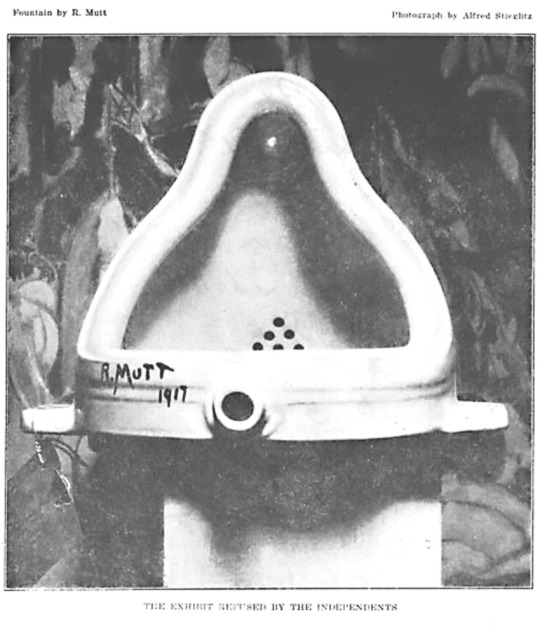
Marcel Duchamp, Fountain, 1917, photograph by Alfred Stieglitz
Stieglitz's photograph, which according to a letter had been taken by April 19, 1917, became a crucial piece of evidence in establishing the existence of the work of art because it was lost afterwards (and had only been seen by a small number of people) (Naumann 2012). Marcel Duchamp believed that the meaning to any artwork arises in the viewer. An object's context determines whether it qualifies as art. Until then, its meaning is unfixed. So the question that made me curious is that from the original artwork to a photograph and then again to a replica, has the meaning changed?
For my studio I'm photographing objects and people who have grown up in a refugee family that migrated to during the partition of India in 1947 just like mine. The idea is to document the material memories that have been passed on from generations. So whenever I'm photographing my subject I think about how the viewers will interpret these photographs.
0 notes
Text
Remembering Partition through "Western Gaze"
In 1947, Henri Cartier-Bresson was on an assignment by Magnum and wanted to produce a photographic essay that would capture the soul of the nation, its past, and its present during a period of significant social change. With the division of the nation into Hindu India and Muslim East and West Pakistan, he witnessed India's recent independence from Britain swiftly degenerated into instability.
Cartier-Bresson captured the bustle of daily life in India as he saw it. He captured everything, from refugees going about their everyday activities to people laying out saris to dry in the sun. Although the focus of "India in Full Frame" is the mythic figure of Gandhi and the outpouring of emotion following his passing, the exhibition also reveals Cartier- Bresson's struggle to blend photojournalism and art photography—a commitment, as he stated in his 1952 essay, "The Decisive Moment," "to preserve life in the act of living." (Cartier-Bresson, 1952)
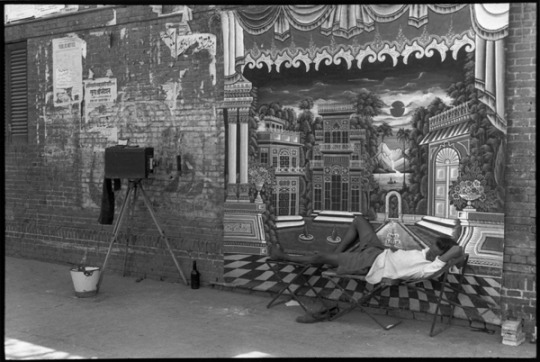
The majority of the photographs presented in 'India in Full Frame' are situated more closely along the photojournalistic line than the artistic line. Such photographs exist apart from the conventional visual connections of reportage, such as malnourished beggars and starving children. In essence, the infant is reduced to a nameless, famished body, which feeds Western stereotypes and limited views of India. However, photographs like Astrologer's Shop (1947) and Street photographer in the old city (1966) defy the journalistic sensibilities Cartier-Bresson largely employed in India and lean more towards his earlier, surrealist work. By fusing a made-up and actual surroundings, Cartier-Bresson's 'Street photographer' from 1966 demonstrates his surrealist sensibilities. The artwork makes a faint, possibly unintended reference to earlier studio photographic techniques used in India. These photographs are a good visual aid for me to understand the life in India during 1947.


Beth Citron's exhibition 'India in Full Frame' does discuss Cartier-Bresson's well documented knowledge of his privilege as a white, male outsider. Cartier-Bresson made an effort to leave his position of advantage while he documented the cremation and scattering of the deceased's ashes. He avoided photographing the gathering from above so as not to suggest a western gaze. The show offers little to challenge the photojournalistic framework in which Cartier-Bresson was working, and his awareness, while present, does not extend to all of his work in India. By leaving out this detail, it is implied that Cartier-Bresson's photographs of India eschew journalistic photographic cliches.
This helps me personally think a lot while I'm photographing people connected to an event that happened 75 years ago. The aesthetic I'm using is very similar to what can be seen in Cartier-Bresson's Street Photographer with a hand painted backdrop, a style which is slowly dying in Indian portrait studios. I focus equally on collecting the narrative and photographing the person sitting in front of the backdrop, creates a performance with their monologues.
Kennedy, Emma. “Henri Cartier-Bresson's Glimpse of India.” Aperture, May 25, 2017. https://aperture.org/editorial/henri-cartier-bressons-glimpse-india/.
1 note
·
View note
Text
Presence of an Absence

Shivanjani Lal is twice displaced Fijian Indian Australian artist. She uses found objects, film, performance, and ritual in her work. Her writing examines the histories that led her family from India to Fiji and later to Australia as well as the diaspora of indentured labour in the Indian and Pacific Oceans. She derives inspiration for her installations, films, and photos from her own loss resulting from the dispersion of her ancestors.
Her ongoing artistic endeavours consistently pay tribute to the tragedy suffered by her family. Shivanjani recreates places associated with her generational suffering in her piece "Yaad Karo" utilising personal family photos and artefacts. The materials and containers used in this exhibit provide the sensation of being a part of a ceremony to honour the first-generation ancestors of her family. By serving as a reminder of the enslaved labour used throughout the colonial era, they are being used to study the temporal aspect of the artefacts. This piece's presentation and site-specificity piqued my interest the most. It inspired me to explore different options.
0 notes
Text
Amrita Sher-Gil
Amrita Sher-Gil has been referred to as a "pioneer" of contemporary Indian art and "one of the greatest avant-garde woman artists of the early 20th century." She attempted to combine the European oil painting skills she had learnt in Paris with the aesthetic of the wall murals of the Ajanta Caves in western India. Sher-Gil was an extraordinary colorist, able to produce special effects with colours that were unrestrained and powerful, in stark contrast to the light hues popular at the time.

This particular still painting named “The Dressing Table” inspires me the most along with a few others. The sombre colour palette and the reflections used to recreate a scene from her grandmother's dressing table gives a meaning of preserving the objects that remind us of someone. All of the Sher-Gil’s paintings were made in the pre-partition era of the colonial India, hence the works give me an insight to the emotional representation of the female figure and Intimate depictions of household scenes during that time. I use these paintings as a lighting reference for my photographs.
“Dressing Table - Amrita Sher-Gil - Google Arts & Culture.” Google. Google. Accessed October 5, 2022. https://artsandculture.google.com/asset/dressing-table-amrita-sher-gil/KAFICEZnZmeS_g.
0 notes
Text
History stored in Vessels
In my studio practice, I work a lot with material memories and narratives of Partition Diaspora. Objects, cultural rituals, recipes that are passed on inter-generationally are a sign of remembrance. Hence I think a lot about how my work will be read among a non-indian audience. Joseph Margolis states that there is no one correct interpretation of a work of art. Since works of art are "culturally emergent" entities and because the cultural myths that we use to interpret them give them the very qualities that we "discover" in them, there is no culturally neutral method of determining the qualities of a work of art that we judge to be true. (Margolis, 1974)
One particular contemporary artist that I'm deeply inspired from is Sancintya Mohini Simpson. Her work addresses gaps and silences in the colonial archive to navigate the difficulties of migration, memory, and trauma. In order to create narratives and rituals, her approach switches between painting, video, poetry, and performance.

This installation called 'Vessels' got a really emotional response from me. clay lota jars become ancestral items that convey these histories through song and performed ritual as a shape that carries, both literally and figuratively. The project pays homage to the forgotten voices in the colonial archives. Coming from an Indian household, these earthen pots lying on a bed of ashes and sand transported me to the feeling of being in a crematorium where the last rites are being performed.
I photograph metallic pots along with different fabrics that once belonged to my ancestors as a homage to a forgotten narratives from the Partition. Simpson's work inspires me to think beyond photographs and experiment with other areas of expanded photography such as sound, projections and point cloud to create an accurate representation of my memory.
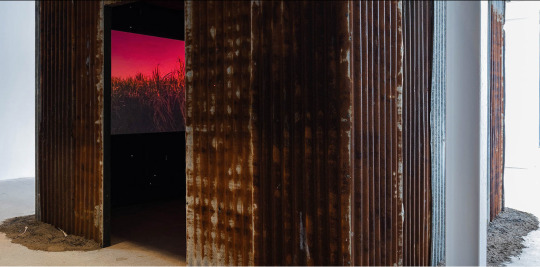
2 notes
·
View notes